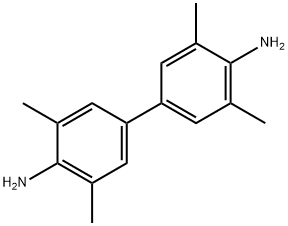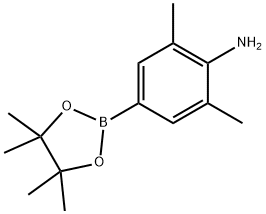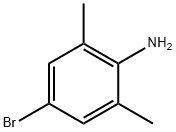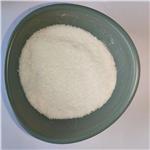Description
Tetramethylbenzidine(TMB) is a chromogenic substrate used in staining procedures in immunohistochemistry as well as being a visualising reagent used in enzyme-linked immunosorbent assays (ELISA). It is a white solid that forms a pale blue-green liquid in solution with ethyl acetate. TMB is degraded by sunlight and by fluorescent lights. It is a soluble chromogen substrate for horseradish peroxidase detection systems. Tetramethylbenzidine is recommended for ELISA procedures.
Chemical Properties
Tetramethylbenzidine is a white or light yellow solid, odorless, tasteless, insoluble in water, easily soluble in acetone, ether, dimethyl sulfoxide, dimethylformamide and other organic solvents. It forms a pale blue-green liquid in solution with ethyl acetate. TMB is degraded by sunlight and by fluorescent lights.
Uses
3,3,5,5-Tetramethyl benzidine is used as a reagent in a sensitive staining procedure for the detection of low levels of heme-associated peroxidase activity of cytochrome
P-450 on SDS-polyacrylamide or agarose gel; non-carcinogenic substitute for benzidine as reagent for the detection of blood and determination of hemoglobin content.
Preparation
The synthesis of 3,3',5,5'-Tetramethylbenzidine involved using 2,6-dimethylaniline as the raw material. The process included activation, oxidative coupling, and purification, resulting in the production of pure material. The yield of 3,3,5,5-tetramethylbenzidine was 65%.
Reactions
TMB can act as a hydrogen donor for the reduction of hydrogen peroxide to water by peroxidase enzymes such as horseradish peroxidase.

Shows the oxidation of 3,3′,5,5′-tetramethylbenzidine (TMB) to 3,3',5,5'-tetramethylbenzidine diimine
The resulting diimine causes the solution to take on a blue colour, and this colour change can be read on a spectrophotometer at the wavelengths of 370 and 650 nm.
General Description
3,3',5,5'-tetramethylbenzidine appears as pale yellow crystals or off-white powder. (NTP, 1992)
Air & Water Reactions
Insoluble in water.
Reactivity Profile
Tetramethylbenzidine is sensitive to prolonged exposure to light . Neutralizes acids in exothermic reactions to form salts plus water. May be incompatible with isocyanates, halogenated organics, peroxides, phenols (acidic), epoxides, anhydrides, and acid halides. Flammable gaseous hydrogen may be generated in combination with strong reducing agents, such as hydrides.
Fire Hazard
Flash point data for Tetramethylbenzidine are not available, however, Tetramethylbenzidine is probably combustible.
Biochem/physiol Actions
3,3′,5,5′-Tetramethylbenzidine/TMB can be used as a chromogen to increase the progression of product obtained in peroxidase reaction. In food and environmental decontamination procedures, TMB can be used in in?situ free available chlorine (FAC) monitoring of chlorite-based sanitizers.
Carcinogenicity
The carcinogenic potential of Tetramethylbenzidine is uncertain due to conflicting evidence. It is not mutagenic by the Ames test, and did not induce formation of tumors in a single-arm study of 24 rats. On that evidence, it has been used as a replacement for carcinogenic compounds such as benzidine and o-phenylenediamine.
DOI:
10.1177/26.2.24068









